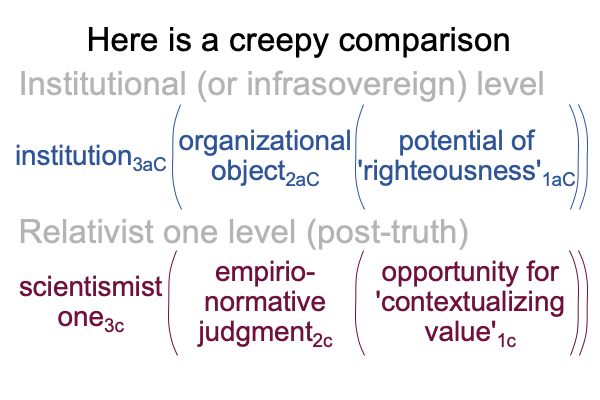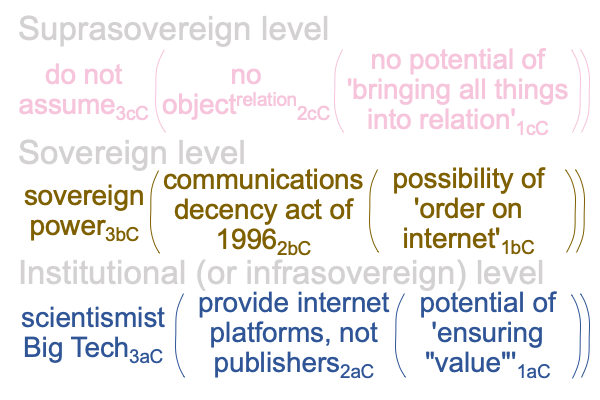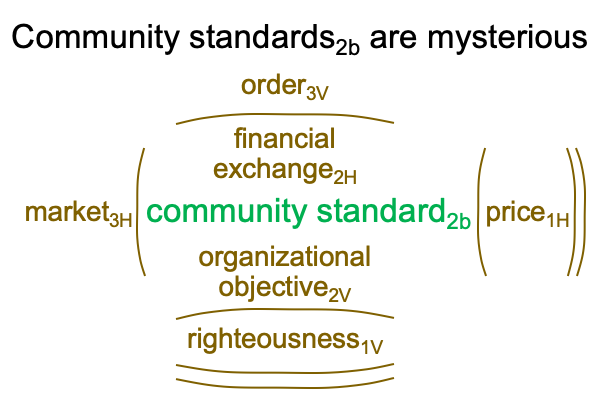0354 Well, my examination of chapter ten ends with a disturbing conclusion.
If wokeism manifests the post-truth condition of scientism3c, contextualizing the intersection of capitalism and socialism2b and operating on the potential of the human will1a, then there is no need for the entire suprasovereignc level of the societyC tier.
Scientism3aC is enough.
Scientism3c brings all phenomena2a into organizationB, through the ministrations of the psychometric sciences2b. The scientismist one3c finds success2c in rendering actionable judgements2c. Actionable judgments2c corresponds to organizational objects2aC of the societyC tier.
0355 How does scientism3aC compare to other institutions3aC?
On one hand, a religious movement3aC that aligns with the suprasovereign assumption3cC will spontaneously organizeB in order to accomplish its3aC organizational objectives2cC. Businesses3aC that provide for obvious needs1aC also spontaneously organizeB as scrappy players strive to get ahead and earn a living. Religious institutions and businesses contribute to civic society. Sovereign power3bC is only necessary to maintain order1bC.
On the other hand, scientism3aC requires sovereign power3bC. How so? Sovereign acts and decrees2bC are required in order to enforce empirio-normative judgments2aC emanating from the righteousness1aC that satisfies the experts3aC.
0356 To me, this implies that the one of scientism3c,3aC is not a spontaneous organization, but a requisition of existing organizations.
0357 In order to drive home this point, consider the creepiness of the following comparison.

Does this comparison imply that the one of scientism3c wants to bring all organizational objects3aC into harmony, with a relational object3cC, on the basis of characterizing righteousness1aC as opportunity1c for contextualizing expert-driven valuations2b?
Or does the scientismist one3c merely promote its empirio-normative judgments2c based on its own opportunities1cwithout regard to consilience1cC to a relational object2cC?
0358 Okay, let me say it again.
My examination of chapters fifteen, backwards to ten, ends with the disturbing comparison pictured above.
0359 In chapter nine, Ramaswamy addresses a prime example of wokeness as an infrasovereign religion3aC: big technology corporations. The beauty of Big Tech3aC is that it is already entangled with the Deep State3bC and serves as a medium through which the sovereign3bC promulgates order1bC under a veil of righteousness1aC.
0360 How does the sovereign3bB, in this case the American Federal Government, establish order1bC on the internet?
Do the words, “market”, “transactional value” and “price” come to mind?
There is more.
Many people rely on big tech corporations for services, such as internet access, that provide a venue for their businesses. The small company website or Facebook page are examples. Typically, in order to run a business, one must have a state license. Licensing businesses is the job2bC of the sovereign3bC.
In 1996, Congress passes and President Bill Clinton signs the so-called “Communications Decency Act”. Ramaswamy discusses this legislation at length. In a certain way, the federal government3bC farms out the internet licensing businessBto big tech companies3aC, by providing internet service providers with legal immunity2bC. This is very similar to a state government not being held legally liable for the actions of a business that it has registered.
0361 So far, so good.
Section 230 says that first, internet providers3aC are not to be treated as publishers. Instead, publishers are those who broadcast using an internet service. Second, the provider may not be held liable for good-faith actions to restrict the access or the availability of obscene, lewd, lascivious… or otherwise objectionable displays of “information”, whether or not such material is constitutionally protected.
Or, something like that.
0362 From what I understand, Section 230 provides a loophole that is large enough to negate the first amendment.
Perhaps, America’s supreme court will rue the day when they ruled that pornography is the same as free speech.
Why?
Some say that “free speech” is “pornography for people who hate”.
Since pornography is obscene, lewd, lascivious… and so on, then any statement that violates “community standards” must be removed from display on the internet, as if it is pornographic.
0363 The rhetoric is rather confusing.
On one hand, actual pornography qualifies as “free speech”.
On the other hand, dissenting opinions must be treated as if they are pornographic and removed from display on the internet.
0364 Ramaswamy proposes an incredibly simple correction. Access to obscene, lewd, lascivious… or otherwise objectionable displays should be restricted, except for material covered by the first amendment of the constitution of the United States.
Imagine the lawsuits that would come from that correction!
0365 Here is a picture of the societyC tier for this example.

On the situation level, the normal context of the Federal Government3bC brings the actuality of the 1996 so-called “Community Decency Act”2bC into relation with the possibility of ‘order on the then-fledgling internet’1bC. The title gives sovereign authority3bC to internet providers3aC in order to first, provide platforms2aC (and not be held liable for the material that is published by users on the platform) and second, ensure that community standards1aC are upheld.
Of course, this raises a question, asking, “Who is going to propose the criteria needed to establish whether internet published material does not violate ‘community standards’?”
Who is going to enforce that criteria?
Am I talking about experts3b?
0366 I suspect the reader can guess where I am going with this.

0367 Community standards2b are constituted by financial exchange2H, associated with a user publishing on an internet service provider, and organizational objectives2V, associated with establishing criteria concerning what is objectionable and what is not objectionable.
Community standards2V can be ensured1aC by internet providers3aC through a wide variety of manipulations, including biasing search algorithms, defunding incentives, as well as temporary and permanent deplatforming. There are a lot of options for experts to employ.
0368 However, one consideration is not mentioned in all the academic discourse on ensuring community standards. That consideration is precisely the one that Ramaswamy points out. No expert discussion takes the first amendment of the constitution2cC into consideration.
0369 If anything, for America as a nation, the founding events and documents occupy the slot for relational object2cC. The American Revolution is the foundation2cC of the United States.
Curiously, the American Revolution is “not religious”. The first amendment of the American Constitution rules out the federal government establishing a religion. Some call the “not religious” relational object2cC of the American Founding a “civic religion”.
But, what does that mean?
0370 So, I ask, “Can a the federal government establish a ‘not religious’ religion?”
There are two types of religion embedded in the societyC tier.
The relational object2cC dwells on the perspective level, also called “the suprasovereign level”, because itcC stands above the sovereignbC (situation) level. Theoretically, a suprasovereign religion2cC cannot be established by a state3bC. How can the state3bC put itself into context?
The organizational object2aC dwells on the content level, also called “the infrasovereign level”, because it2aC stands below the sovereignbC (situation) level. Now, a state3bC can establish an infrasovereign religion2aC, simply by using sovereign decrees2bC to implement organizational objectives2aC of an institution3aC.
0371 The first amendment decrees that the federal government may not establish a religion.
What does this imply?
A Christian faction3aC cannot demand that sovereign decrees2bC implement its organizational objectives2aC.
The sovereign3bC cannot establish an infrasovereign religion3aC (Christian faction).
But, can the sovereign3bC establish an infrasovereign religion3aC that proclaims itself to be “not religious”?
Hmmm.
0372 The 1996 Communications Decency Act does not assume that the suprasovereign level exists. The same Act2bCimplements the organizational objectives2aC of big tech institutions2aC by giving these institutions the legal authority2bCto censor anything that proves offensive to certain experts.
0373 The question arises, “Do the experts who want to ban certain political expressions constitute an institution3aC, contextualizing organizational objectives2aC, that emerge from (and situate) righteousness1aC.”
And, does that institution3aC demand sovereign power3bC in order to institute its organizational objectives2aC?
If the answer is “yes”, then sovereign power3bC establishes an infrasovereign relgion3aC.
